Home
Camera Articles
FOR SALE
Orders
I Buy / Wants Repairs
Books
Adapters
Canon EOS Adapters--
Adaptable Modern SLR
|
In my opinion, the CameraQuest
Rayqual EOS adapters are are the best Canon EOS Lens Adapters
made. |
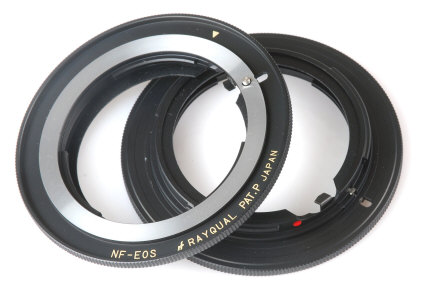
"Stephen,
My new CameraQuest Nikon to Eos adapter beats the pants off the
2 Novoflex adapters we have been using with our 1DM4's and Nikon
AI primes here on In Plain Sight (USA network series). The
Novoflex isn't tight, allowing the lens to rotate slightly. The
image jumps when the focus-puller changes direction. Your adapter
is rock-solid, no matter how stiff the lens. Looks better too.
Great product.
Thanks,
Ralph Watson"
|
Lens Adapters for
Canon EOS Bodies
NO GLASS to
degrade image!
ORDER
HERE
- for film or digital bodies!
Precision Made Quality
Adapters
- Not Cheap Loosely Fitting
knocks offs! |
Contax/Yashica SLR
Lenses (not G) $199 Sale $175
Leica R Lenses
$199 Sale $175
Leica Visoflex Lenses $229
Nikon SLR Lenses
with Aperture Rings $199 Sale $175
Nikon G (and non G) Lenses
$229 Sale $199
(for lenses without aperture rings)
Olympus OM Lenses
$199 Sale $175
Pentax 42 Screw
Mount Lenses $125 Sale $99
Pentax K
Lenses! to EOS EFS Bodies $199
Sale $175
Pentax PDA Lenses
to
EOS EFS Bodies $229
Sale $199
(for lenses without
aperture rings) |
| All adapters listed here
have ZERO glass elements to degrade image quality - providing you with
the maximum quality image your lens can produce. ALL adapted focus
properly to infinity. All provide manual focusing, not AF. The
photographer must control the aperture on the lens, not the camera.
Generally most bodies offer spot metering and central weighted metering
on adapted lenses, together with manual or aperture priority exposure
control. Metering is done at stop down or shooting aperture. These
limitations are tradeoffs allowing you access to a much larger wider of
lenses that your camera was not designed for. Some users report better
results with focusing screens designed for manual focusing rather than
the standard AF focusing screens. |
Contax / Yashica Lenses
on Canon EOS Bodies $199
Sale $175
ORDER HERE
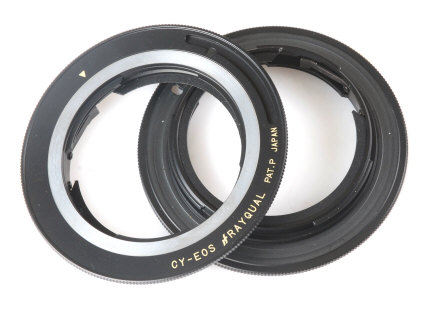
Contax/Yashica Lenses: CEOS,
mounts manual focus Zeiss Contax RTS lenses on EOS. Unlike some Contax
/ Yashica to EOS adapters, the CameraQuest adapter does
NOT require a set screw. Not only do you not have to worry about losing
the screw, this adapter is much faster to mount than adapters requiring a set
screw. The EOS digital bodies are a great digital option for your manual focus
Zeiss Contax/Yashica lenses. These adapters are NOT for
Zeiss N series lenses, or G series. Mount the lens onto the adapter,
then mount the lens with adapter on the EOS body. To remove, remove the
lens/adapter together. You can see the locking latch on the back of the
adapter pictured above. When pushed, you can remove the adapter from the lens.
There has been some internet discussion
claiming it is best to use different thickness Contax/EOS adapters for
different Contax/Yashica lenses. While I admit I have no proof to the contrary,
I have to say personally I find such a claim impossible to believe. I don't
believe ANY lens maker, especially Zeiss, would design lenses within the same
lens line with a different back focus, beyond their normal manufacturing
tolerances. However don't take my word on this, just email the good folks at
Zeiss.com to get it from the horse's mouth.
Contax/Yashica lenses were discontinued January
2005 once Kyocera and Zeiss dissolved their partnership and discontinued
the entire Contax lineup. Prices started going up on the harder to find
lenses, especially the ultra wides, in big part because EOS shooters became
dissatisfied with Canon ultra wide lens performance.
LENSES WHICH WILL NOT WORK:
Reportedly the following adapted Contax lenses are not compatible with the EOS
5D: 18/4, 85/1.2, and 135/2. There have been conflicting OK/Not OK reports on
the Contax 28/2.8, perhaps suggesting unreported lens variations.
Lens mount variations have been reported on the 28/2.8 MM and the 35-70
MM lenses. These lenses may require about 1mm to be filed from the end of the
brass locking latch, before the lenses will lock on the adapter. Take note
that if you do this modification, the adapter may or may not lock on other
Contax lenses.
The Canon 5D has a larger than normal EOS mirror, so take extra care
mounting lenses. This list is not represented as complete. If you find other
Contax mount lenses which will not mount safely on the EOS adapters, let me know
and I will add to this list.
Leica R Lenses: REOS:
allowing R lenses to be used on
your EOS in stop down mode. On most bodies this means you will be
able to get manual exposure, aperture priority exposure, TTL flash.
Mount your R lenses on a digital EOS for digital
SLR capability! $199
Sale $175
ORDER
HERE
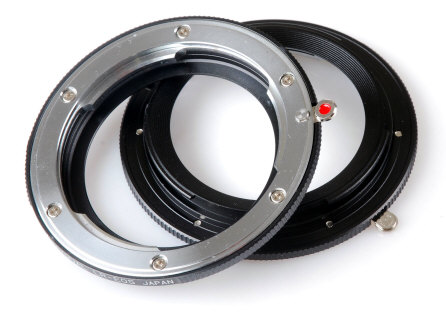
- Optional AF with your Leica system?
Not a problem, mount a Canon lens. Try that with your R8 !!!
- 10 fps with your Leica R lenses?
Not a problem with the Canon EOS 1n RS.
- Real motor drives built into the camera
with R lenses? Gee, pick an EOS, almost any EOS.
- Wireless Multi TTL Flash with R lenses?
Haven't tried it yet, but I think its possible with your EOS and this
adapter.
- Compact light weight low cost R body with
built in flash for R lenses? You only have about 200
Canon Rebel models to choose from.
- Sophisticated rugged pro camera with R
lenses? The EOS 1 V or digital Mark II DS fit the bill.
- Digital SLR? The Canon EOS digital
bodies are popular with manual Leica R glass.
- It will probably be easier to mount the
adapter on your lens first, and then mount on the camera.
- Exposure Compensation: For most EOS
bodies, set the finder F/stop display to 1.0 or 0.0 for stop down metering.
Test the exposure compensation necessary for that camera/lens combination.
- IF you are using the large heavy Leica tele
lenses which have both R and Visoflex mounts, it is probably wiser to
use the
Visoflex to EOS adapter as it is larger and likely stronger than the R
to EOS adapter..
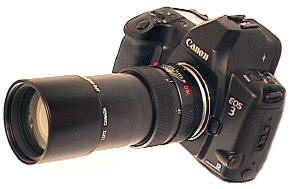
Leica R 180/3.4 APO mounted on Canon EOS 3.
- R Lenses Which will NOT work:
Strangely enough not all Leica R lenses protrude in identical ways
into camera bodies. The following Leica R lenses are
reported to have mirror clearance issues with most if not all adapted EOS
cameras: 15/3.5, 16/2.8, 19/2.8 Second Version, 21/4 Mirror Lock Up
Version, 35/1.4, 35-70/2.8, 80-200/4.5 First Version. The 24/2.8 and
28-70/3.5-4.5 (2nd version) will not work on the EOS 5D because the rear
element protective guard hits the mirror. The 21-35/3.5 Aspherical and
28-90/2.8-4.5 Aspherical is reported not to work on the 1Ds Mk II. Keep in
mind there are minor design changes during a lens' lifetime (most of which
are not reported by manufacturers), and so the changes are unknown to the
public. The first time you mount any adapted lens to
any adapted camera, it only makes prudent sense to carefully check mirror
clearance. The Canon 5D has a larger than normal EOS mirror, so
take extra care mounting lenses. This list is not
represented as complete. If you find other Leica R mount lenses
which will not mount safely on the EOS adapters, let me know and I will add
to this list.
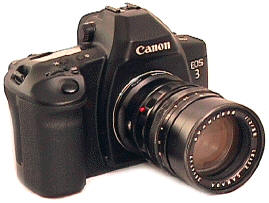
Leica M Visoflex Lenses:
for Canon EOS or NIKON $229:
As far as I am concerned, this adapter is a HUGE improvement
over using Leica visoflex mount lenses on ANY SLR, instead of using them on
the awkward Visoflex/Leica M body combination they were designed for.
More INFO and PICS HERE Leica visoflex lens to SLR body adapters are
available Nikon, Leica R, or Canon EOS mounts. You can leave the adapter on the
camera body while interchanging visoflex lenses. You still need whatever Leica
focusing helical or adapters are necessary to mount the Viso lens on the regular
Visoflex. The adapter simply replaces the Visoflex housing so you can use the
lens on an SLR.
ORDER HERE
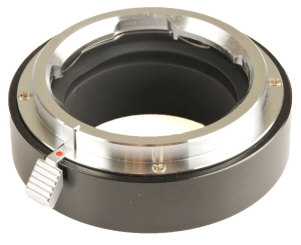
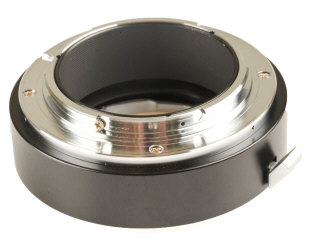
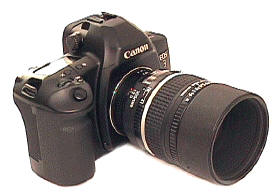 Nikon
F Lenses: NEOS - For Lenses WITH Aperture Rings
$199 Sale
$175 -
allowing Nikon F lenses (AF or manual focus)
to be used on your EOS in stop down mode. On most bodies this means you
will be able to get stop down manual exposure, aperture priority exposure, TTL
flash. In my opinion these are better adapters than the better known Novoflex
Nikon to EOS adapters. These adapters usually mount and remove more easily.
This is also a new improved design with a light shield which prevents
reflections off the rear of the chrome Nikon bayonet lugs.
ORDER HERE
Nikon
F Lenses: NEOS - For Lenses WITH Aperture Rings
$199 Sale
$175 -
allowing Nikon F lenses (AF or manual focus)
to be used on your EOS in stop down mode. On most bodies this means you
will be able to get stop down manual exposure, aperture priority exposure, TTL
flash. In my opinion these are better adapters than the better known Novoflex
Nikon to EOS adapters. These adapters usually mount and remove more easily.
This is also a new improved design with a light shield which prevents
reflections off the rear of the chrome Nikon bayonet lugs.
ORDER HERE

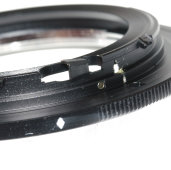
- Works with most Nikon manual focus and AF lenses WITH APERTURE RINGS,
except the digital Nikon DX lenses which do not cover the full 35mm film
format, or cheap XX lenses which have no aperture control ring.
- Wireless Multi TTL Flash with R lenses?
Haven't tried it yet, but I think its possible with your EOS and this
adapter and stop down metering.
- Multi-Spot metering ? sure, if your EOS body allows it
- Best of all, you can finally get some great glass on that EOS
body ! Relax Canon fans, just joking.
- Mount the lens onto the adapter, then
mount the lens/adapter on the EOS body. To remove, remove the
lens/adapter together. There is a latch on the back of the adapter. When
pushed, you can remove the adapter from the lens.
- The NEW version of this adapter
includes a rear flange which shields the camera sensor from reflections off
the rear of the Nikon bayonet mount!
By way of comparison, it runs over $700 to have your
Nikon SLR converted to R mount, takes about four months to do, and is not
reversible. A R to Nikon adapter won't do the job
since the Nikon body is not thin enough to mount the adapter and still allow
infinity focusing. Even then, the Nikon to R conversion doesn't give
you lens to body coupling, either.
Nikkor Lenses which will not work:
Mirror lock up lenses which will not work include the 6/5.6, 7.5/5.6, and
21/4 Nikkors. G series Nikkors with no aperture control ring -- no way to
control the f/stops. The first time you mount any adapted lens to any adapted
camera, it only makes prudent sense to carefully check mirror clearance. The
Canon 5D has a larger than normal EOS mirror, so take extra care mounting
lenses. The 20/2.8 AIS and 24/2.8 AIS are reported to be incompatible with the
5D due to the protruding rear element. This list is not represented as
complete. If you find other Nikon mount lenses which will not mount safely on
the EOS adapters, let me know and I will add to this list.
Nikon
G Lenses: NFG-EOS - For G Lenses
WITHOUT Aperture Rings
$229 Sale $199
ORDER HERE
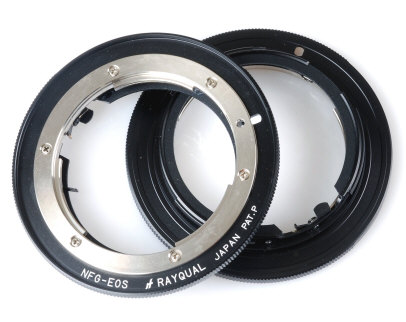
The NFG_EOS adapter
is for Nikon F G lenses WITHOUT aperture rings.
Mount the lens on the adapter,
then the adapter and lens together onto your EOS Body. Like all the other
adapted EOS lenses, you will manually focus the lens. Control the aperture
by turning the lens while it is mounted on the adapter - yes you can do
this! You will see three round circles on the edge of the adapter as
reference points for your chosen aperture. There are no marked apertures on
the adapter as that varies with the lens you have mounted. To remove the
adapter, REMOVE the lens and adapter together from your EOS. Push IN the
catch on the rear of the adapter, and then rotate the adapter off the
lens. Please note this adapter does double duty with lenses that have
aperture rings - just control the aperture on those lenses by turning the
aperture rings as usual.
Olympus
OM Lenses on Canon EOS Bodies
$199 Sale
$175
ORDER HERE
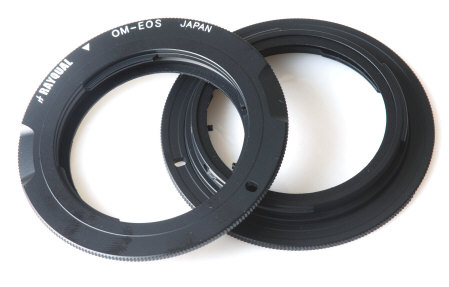
Olympus OM Lenses: OEOS,
mounts Olympus OM lenses very conveniently on the
EOS via the adapter. The EOS digital bodies are an excellent digital
options for your manual focus Olympus OM lenses. Mount the lens onto the
adapter, then mount the lens/adapter on the EOS body. The lens will
automatically stop down to the f/stop you have selected on the aperture ring.
IF you want to use the stop down switch on the lens instead, remove the long
screw on the back of the adapter . You can leave the OMEOS adapter on the
camera and just interchange OM lenses. Remove the adapter from the body with
the lens, then remove the adapter from the lens. Unlike some Leica R or Contax
lenses, Olympus OM lens clearance problems have not yet been reported with
adapted EOS cameras. However, such problems might exist with some lens
variations, so exercise caution when using a lens/camera combination for the
first time. The Canon 5D has a larger than normal EOS mirror, so take extra
care mounting lenses.
NEW Pentax K to Canon
Digital EF-S Mount EOS!
ORDER
HERE
Pentax K Lenses! to EOS EFS Bodies $199
Sale $175
NO Glass in adapter to
degrade image. Manual operation like the other EOS lens adapters. Many believed
this adapter was impossible to make without glass elements.
This adapter is NOT for EOS film cameras, or larger format EOS
digital cameras. It is for EOS EF-S mount digital cameras
NEW Pentax K DA to
Canon Digital EF-S Mount EOS!
ORDER HERE
For DA Lenses WITHOUT Aperture Rings
Pentax PDA Lenses
to EOS EFS Bodies $229
Sale $199
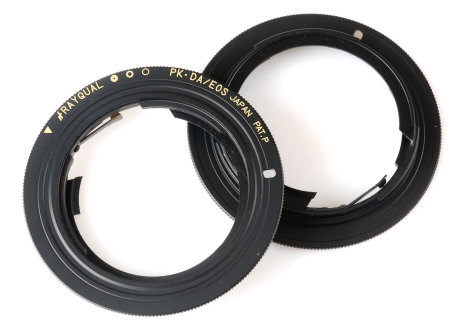
NEW Pentax K DA to
Canon Digital EF-S Mount EOS!
For DA Lenses WITHOUT Aperture
Rings. IMPORTANT: This adapter is ONLY for
the smaller format EF-S Digital EOS cameras. Check your instruction book to
make sure your EOS body is EF-S! Mount the lens on the adapter, then the
adapter and lens together onto your EOS Body. Like all the other adapted
EOS lenses, you will manually focus the lens. Control the aperture by
turning the lens while it is mounted on the adapter - yes you can do this!
You will see three round circles on the edge of the adapter as reference
points for your chosen aperture. There are no marked apertures on the
adapter as that varies with the lens you have mounted. To remove the
adapter, REMOVE the lens and adapter together from your EOS. Push IN the
catch on the rear of the adapter, and then rotate the adapter off the
lens. Please note this adapter does double duty with standard K / KA
lenses having aperture rings - just control the aperture on those lenses by
turning the aperture rings as usual.
Pentax
M42 Screw Mount Lenses on Canon EOS Bodies
$125 Sale $99
ORDER
HERE
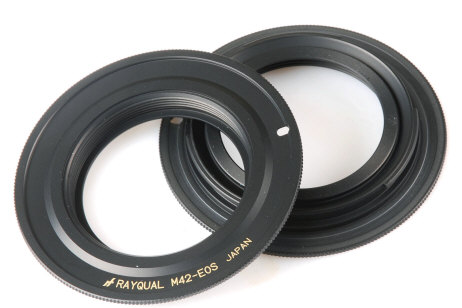
Pentax Screw Mount Lenses: PEOS,
allowing
Pentax 42mm screw mount lenses to be used on your EOS in stop down mode.
NEW IMPROVED VERSION:
All black to cut down internal reflection in the mirror box. Now
has ridge on the back which also helps reduce flare, the same idea as the
Nikon-EOS adapter above. The other side of the ridge depresses the auto
diaphragm, so that even lenses without auto/manual aperture switches can now
be used at your choice of f/stop on your EOS. This new version is a big
improvement over the old version adapter. The EOS digital bodies are a
great digital options for your classic Pentax screw mount lenses. You can
remove the lens/adapter combination together, or leave the adapter on the
camera body and simply unscrew the lens.
The first time you mount any adapted lens to any adapted camera,
it only makes prudent sense to carefully check mirror clearance. If you
find a Pentax screw mount lens which will not mount safely on the EOS
adapters, let me know and I will add to this list. The Canon 5D has a
larger than normal EOS mirror, so take extra care mounting lenses.
With the thinnest
35mm SLR body currently being manufactured,
Canon EOS bodies (film or digital) are more adaptable to more different
lenses than any other standard 35mm format SLR / DSLR. All adapters
listed on this page offer focusing throughout the lens's focusing range,
infinity focus, no glass elements to degrade image, manual
focusing, stop down metering at shooting aperture, and quality precision
manufacture. All of the adapters listed on this page allow you to use non EOS
lenses on EOS film and digital cameras. Side Note: The
manual focus Canon R/FL/FD series SLRs also accept Nikon F, Exakta, or
Pentax Screw mount lenses with the correct classic, and now hard to find
adapters. There is NO FD lens to EOS body adapter available without glass to
make the focus correct. Unfortunately the glass degrades image. I do not sell
adapters with glass elements.
WHICH CANON EOS FLAVOR DO
YOU HAVE? It turns out the MOST adaptable EOS bodies are the APS smaller
than full frame digital bodies. These digital EF-S mount bodies have less
restrictions internally. Next most adaptable are the film EOS bodies and the
full frame Digital Sensor EOS bodies -- except for the 5D. The full frame 5D
body has a different mirror, which means less compatibility than the other EOS
bodies.
THE ADAPTER ADVANTAGE is
versatility, saving money by continuing to using
favorite lenses you already have, and in some cases using better lenses than
those available in EOS mount. These are very useful
adapters, allowing you to combine elements of SEVEN fantastic systems: Leica R,
Leica Visoflex, Nikon F, Pentax Screw, Contax/Yashica, Olympus OM, and Canon
EOS. The adapters themselves are precision
machined and fit very well.
THE DISADVANTAGE is
inconvenience. There is no linkage between the EOS
body and the adapted lens. You will have manual focus only. You will manually
control the lens aperture. For example, if you set the lens aperture ring at
f/11, the lens aperture is indeed at f/11. IF you want the lens to be wide
open, you manually open it by turning the lens aperture.
FOCUSING SCREENS:
Canon EOS are autofocus cameras with focusing screens not optimized for manual
focus photography. The old Nikon F/F2 had focusing screens optimized for wides,
normals, and teles. The least accurate focusing is the easy and quick split
image focusing screen, because it effectively has a very short rangefinder base
length for all lenses. Whenever the split image focusing disagrees with the
background microprisms or ground glass -- believe the
background focusing aids, NOT the split image! Interestingly, some EOS
instruction books warn that split image focusing may lead to inaccurate metering
-- so check your particular instruction book.
MIRROR LOCK UP:
There are various super wide angle SLR lenses designed to mount with the SLR
mirror locked up. This means the viewing mirror can be locked up on that
particular body, and it stays locked up until the photog lowers it back into
normal position, in order to mount and use that particular "mirror lockup"
lens. While a few Canon EOS has a pseudo mirror lock up command which brings
the mirror up, it immediately goes back down again after the exposure. As far
as I know, no EOS has the traditional "mirror locks up and stays up" mirror
command. Accordingly no EOS should be used with a mirror
lock up lens via a lens adapter.
What functions will be
available with these adapters on YOUR EOS camera body? As far as the
camera is concerned, with no electronic contacts providing lens information, the
body does not know the adapter and the lens is there -- just like when it is
connected to a bellows. Check the instruction book to find out what functions
YOUR camera body has when attached to a bellows. Generally this works out to be
centerweighted metering using metered manual or aperture priority AE metering
(you set the f/stop, the camera sets the shutter speed) at the actual shooting
aperture. Shutter AE priority, Programmed AE, and computerized matrix type
metering will not be available with lens adapters mounted. Some EOS may seem
to function with evaluative metering, but if you check the instruction booklet,
you will probably find it has defaulted back to centerweighted metering.
You can Leave the Adapter
on the EOS body and change lenses using the Olympus OM, Visoflex and Pentax 42
Screw Mount adapters.
With the Contax, Leica R, and Nikon
adapters, mount the adapter on the lens first, and then mount the lens
and adapter on the camera. While it is
feasible to use one adapter for many lenses, in practice it takes up a lot more
time. A push in catch on the back of the Contax
and Nikon adapters allows you to remove the adapter
. It is much easier to remove the lens with adapter from the camera body, than
it is to remove the adapter from the lens. IF you want to switch lenses
quickly, use one adapter for each lens. The rear elements of some lenses,
especially deep-seated wides, may hit the EOS mirror, so be careful.
Yes, the adapters work with both film and digital
EOS.
Canon EOS 5D:
Canon has changed the size of the 5D mirror, or perhaps the swing of the
mirror, or both. This has resulted in some rear elements hitting the mirror,
lenses that work fine via adapters with other EOS models. With the 5D exercise
caution to avoid this problem. Adapted lenses which have been reported not to
be 5D compatible are listed under the camera type. Some dedicated gearheads
modify lenses or even camera mirrors to get that adapted lens mounted.
Obviously such modifications are at your own risk, and NOT generally advised by
any camera or adapter manufacturers.
Back To Lens
Adapter Main Page
Home
Camera Articles
FOR SALE
Orders
I Buy / Wants Repairs
Books
Adapters
Revised: September 14, 2013 .
Copyright © 1999-2013 Stephen Gandy. All rights reserved. This
means you may NOT copy and re-use the text or the pictures in ANY other internet
or printed publication of ANY kind. Information in this document is subject to
change without notice. Other products and companies referred to herein are
trademarks or registered trademarks of their respective companies or mark
holders.







 Nikon
F Lenses: NEOS - For Lenses WITH Aperture Rings
$199 Sale
$175 -
allowing Nikon F lenses (AF or manual focus)
to be used on your EOS in stop down mode. On most bodies this means you
will be able to get stop down manual exposure, aperture priority exposure, TTL
flash. In my opinion these are better adapters than the better known Novoflex
Nikon to EOS adapters. These adapters usually mount and remove more easily.
This is also a new improved design with a light shield which prevents
reflections off the rear of the chrome Nikon bayonet lugs.
Nikon
F Lenses: NEOS - For Lenses WITH Aperture Rings
$199 Sale
$175 -
allowing Nikon F lenses (AF or manual focus)
to be used on your EOS in stop down mode. On most bodies this means you
will be able to get stop down manual exposure, aperture priority exposure, TTL
flash. In my opinion these are better adapters than the better known Novoflex
Nikon to EOS adapters. These adapters usually mount and remove more easily.
This is also a new improved design with a light shield which prevents
reflections off the rear of the chrome Nikon bayonet lugs.




